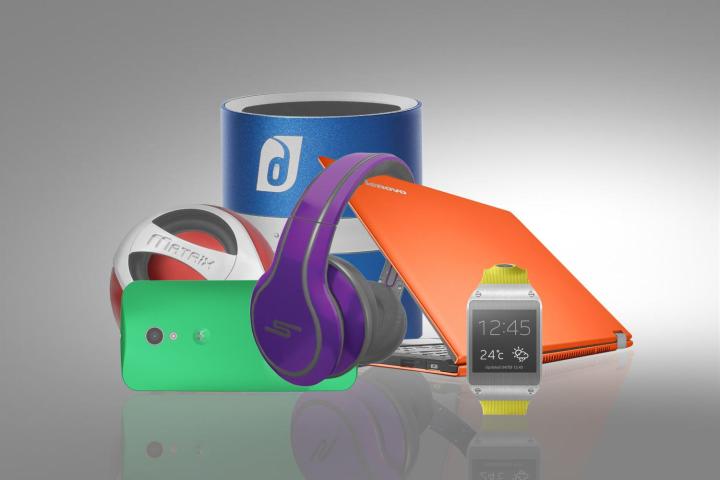
Sexy. There are many contexts in which that word can be used, and few of them feel more inappropriate than consumer electronics. Try as we might, tech journalists haven’t managed to make a solid connection between hardware and sex appeal, and Apple’s mocking portrayal of computer users as dull shut-ins still feels like a humorous reflection of reality five years after the last ad ran.
That’s ironic, consideringApple is in large part responsible for the current state of affairs. The company’s decision to abandon playful, colorful products in favor of sleek metallic design has inspired a generation of devices that show more silver than a bingo hall. Consumer electronics design now seems to follow Cupertino’s lead – and that’s why the colorful new iPhone 5C is a very good thing.
Once, there was color
In 2003, I used an iBook for the first time. Loaned to me from a college friend, I was somewhat taken aback by the funny little clamshell’s colorful exterior. The PC notebooks I’d used up till then were big, angular and serious, which is a complicated way of saying they were drab.

Today, it’s easy to forget that color was the one common theme bridging the old iMac, iBook, and iPods. The bright accents of Apple’s products implied a playfulness and youth that the company’s competitors didn’t possess. This was embodied in the classic “I’m a Mac” ads which, coincidentally, ended as the company’s few remaining colorful products (like the iPod) lost ground to newer, more reserved replacements.
Apple’s former energy has, over the last five or six years, been replaced by a more serious and reserved demeanor, one that would rather advertise with product pictures on a blank white background than with crazed teenagers dancing across neon backgrounds.
Now a trendsetter
The difference between today and 2003, however, is that back then no one cared about Apple. There were always faithful fans, of course, but analysts were just starting to realize the iPod was not a flash in the pan but, in fact, the king of the emerging MP3 player market. The attitude of serious technology companies like Microsoft, Intel and HP didn’t change until the iPhone emerged in 2007, when it promptly destroyed notion that high-end smartphones were meant for tech geeks and titans of industry.

Apple’s influence is now obvious, and it extends far beyond headline-grabbing design disputes like the squabble with Samsung over whether TouchWiz was an iOS rip-off. Intel’s Ultrabook standard is clearly based of the MacBook Air, which boasted the category’s features as early as its 2008 revision. Microsoft is working tirelessly to reform itself in Apple’s image, hoping that vertical integration will prove to be a cure-all. And even televisions, which now feature app stores and a faux-touch interface (controlled by remote or gestures) pay some small tribute to the influence of Apple design.
Enter the iPhone 5C?
Ten years is a long time. The iBook I used back in 2003, though novel, had no chance of making a mark because the consumer electronics industry as a whole didn’t care what Apple products looked like. The debut of the iPhone 5C, however, offers a chance to move the dial. Apple sold more than 9 million of its new iPhones in the first weekend, and while it seems likely the iPhone 5S made up the lion’s share (perhaps no great surprise, as it is the latest-and-greatest) the more affordable iPhone 5C has likely sold between 1 and 2 million units. For perspective, the Motorola X sells about 100,000 units every week.
More importantly, the decision to release a colorful iPhone, along with the new, more colorful look of iOS, indicates a shift in design at the top of Apple. Sleek silver, black and white may be on its way out or, at the very least, complimented by more colorful products sold at affordable prices. If those products sell (as they most likely will), others companies will follow suit. The tyranny of silver will finally be broken.

Some readers will no doubt argue that Apple is in this case the copier, as Nokia has already made color a major part of its Windows Phone devices. That’s true, but no one cares about Nokia smartphones, just as no one cared about iBooks in 2003. A Lumia would never change the industry, but an iPhone might.
Please, make silver go away
Perhaps I’m wrong about the importance of the iPhone 5C’s colorful exterior. Maybe few people will buy it, and Apple will quietly forget that it ever happened. Maybe it’s a one-off, and color won’t leak back into the company’s other products. Or maybe the competition will simply say “that’s nice, but we’ll stick with silver.”
But damn, I hope not. The silver and black which dominates technology is dreadfully tedious and long overdue for a change. With luck, the iPhone 5C’s color will shock everyone into thinking differently.


